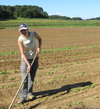Monday and Tuesday afternoons, I work the farmstand.
The red barn sits back from the intersection of two busy roads in Riverhead, Long Island. Behind it lay the fields from which all our produce is harvested. Our lawn, now that it is October, is covered in hay, corn stalks, and pumpkins. Albeit brought in from other farms and rather contrived, the scene attracts city and suburbia dwellers who flock to the farm to get a taste of autumn.

A big draw is the animals. We have miniature goats, some sheep, and a crazy looking cow. There is also a small chicken coop with about six hens and a super aggressive rooster (watch out, he will attack and leave scars; I’m living proof!) The animals eat the refuse when we can’t sell it anymore – wilted greens, smushy tomatoes, carrot tops. Kids and adults stop by every day just to feed the animals, our living compost.
Many people walk through the farmstand just to read the names of vegetables. In their thick Long Island accents, they exclaim, “Look at that, Golden Zucchini! Well, it is yellow!” or “Wow, I’ve never seen a white eggplant!” and “Cheese squash! Never heard of a cheese squash!” Or, they drag their toddlers in, saying, “Look honey, this is an orange tomato,” and “Kale is kind of like lettuce. See how frilly it is? Isn’t that pretty?”
I like to come out from behind the register and talk with them. I tell them how to cook these bizarre foods. Why they have so much flavor compared to the produce that is shipped in refrigerated truck and shrink-wrapped into preserved taste oblivion. How they are grown. What we had to do to get them from the ground into the farmstand to sell. Why it is worth $2 a pound for onions and potatoes, $5 a dozen for eggs.
I believe in this food. I want people to buy it and eat it and discover how good food can be. I want them to consider this a health investment, a longevity investment, an economic investment.
Coming out to the farm from New York City or even the suburbia of Long Island brings you into a different world. From the take-out capital of the world where entire meals are sold in Styrofoam trays from street vendors to the dirty reality of muddy beets. It’s good to get your hands dirty; get some dirt under those manicured French tips; smell the earth in the freshness of your food.

So wherever you are, go visit a farm this fall. See what kinds of produce they are harvesting. Feed some goats. Roll in the hay. Pick pumpkins. And know that you know where your food comes from.
—————–

Alexandra Buck is a novice apprentice at an organic working farm on the
North Fork of Long Island, New York. She served as Young Adult Intern
at the Presbyterian United Nations Office 2007-2008 before making the
move to get her hands dirty at the farm. She loves beets as big as your
face, heirloom tomatoes, pumpkin patches, and regeneration.